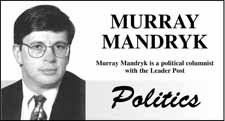This year's budget theme, "The Saskatchewan Advantage", was chosen by the political spin-doctors to drive home a couple political points.
First, today's Saskatchewan has an advantage over the Saskatchewan of the past that struggled with bad economies and deficits.
Second, today's Saskatchewan clearly has an advantage over most every other province whose current economy can't afford them the luxury of a $115-million surplus, a $325-million debt reduction and a $200-million tax cut as we saw in Wednesday's budget.
However, the biggest advantage in Saskatchewan right now might very well be the advantage rural people have compared with the no so distance past. In fact, the 2011-12 budget presented by Finance Minister Ken Krawetz is a pretty good illustration of this.
Of course, some rural communities struggling to keep their hospitals, nursing homes and schools open might take umbrage with the above. There's always a good argument that rural people are the first to feel the pinch. Even this largely good-news budget may illustrate that point. (For instance, one of the few negatives in the recent budget was the loss of 274 jobs. Of those lost jobs, 87.5 jobs were in highways - the hardest hit department and a department that employs a disproportionally high percentage of rural people.)
But notwithstanding such occasional bits of bad news, rural Saskatchewan fared exceedingly well.
In general terms, the budget's tax cuts that benefited small businesses (the tax rate will be reduced to two per cent form 4.5 per cent) and it raised the basic income tax exemption to $14,535. This will likely have a greater impact in rural Saskatchewan that has proportionally more small businesses and more people with lower incomes.
However, the really big advantage for rural Saskatchewan in the budget is clearly the $55.6-million reduction in 2011 in education property taxes that includes a $31.3-million saving on farmland in this coming year.
And when it came to departmental spending, rural Saskatchewan seemed to do equally well.
While the highways budget ($380 million) is down nearly $20 million from the near-record capital spending proposed last year, there remains a healthy $285 million for repaving and capital infrastructure projects, $129 million for bridge and road restoration and maintenance and $25 million for winter maintenance.
Those roads slated for upgrades include Hwy. 219 (north of the junction of Hwy. 15), Hwy. 21 (from Leader to north of the South Saskatchewan River), Hwy. 55 (from Peerless to the Alberta border) and the further twinning of Hwy. 11 (from Hague to north Duck Lake and to south of MacDowall).
Also, all cities, towns and villages will see government grants increase to $138.7 million (compared with $107.1 million last year) while the grant to rural municipalities will increase to $62.9 million (compared with $48.6 million last year) - a 29.5-per-cent increase. In terms of specific communities, that's $1.9 million for Estevan ($400,000 more than last year), $2.8 million for Yorkton, ($600,000 more), $2.5 million for North Battleford ($600,000 more), $1.8 million for Weyburn ($400,000 more), $940,000 for Humboldt ($22,000 more), $780,000 for Melville ($180,000 more) and $970,000 for Melfort ($22,000 more).
The big winner in the budget, however, may have been agriculture that received $418 million - a $32-million increase over what was proposed in last year's budget.
Besides the agricultural land property tax reduction that completes the Sask. Party election promise of an 80-per-cent tax cut, the government is providing record amounts for crop insurance coverage and unseeded acreage benefits.
The budget is also seeing seven new agriculture extension services satellite offices (in Meadow Lake, Lloydminster, Assiniboia, Moosomin, Estevan, Shaunavon and Wadena) as part of two-year pilot project.
Finally, a five-year, $26-million renewable diesel program will provide a 13-cent-a-litre grant to eligible diesel fuel producers. In turn, this will also provide a market for poor-quality canola.
In this budget, the advantages to rural Saskatchewan seem numerous.
Murray Mandryk has been covering provincial politics for over 15 years.




